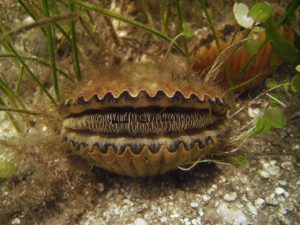MAN do folks in the Florida panhandle like scallops. I recently visited boat ramps at Steinhatchee and Keaton Beach (in the Big Bend) and the parking lots were full of trucks and boat trailers belonging to people combing the grassbeds of the Gulf searching for this popular bivalve. Scalloping is a fun activity that gets the whole family outside snorkeling and finding all sorts of local marine life. And scallops taste good… their sweet meat broiled in butter is a real Florida panhandle treat. Many locals remember years ago collecting scallops with family and friends in Pensacola Bay area …. Good times!

http://myfwc.com/fishing/saltwater/recreational/bay-scallops/
But that was another time. Scallop populations have declined across Florida’s Gulf coast. Today commercial harvesting is banned and recreational harvest is limited to the Big Bend area between the Bay/Gulf and the Hernando/Pasco county lines (visit map). Within this area there is a seasonal limit, bag limit, and harvesting equipment limits. The season runs from Jun 25 – Sep 24 (except in Gulf County). Harvesters can collect 2 gallons whole (or 1 pint cleaned) / person / day. There is a maximum of 10 gallons whole / vessel / day. You can collect by hand or using a dip net. All harvesters are required to have a Florida saltwater fishing license unless (a) they are exempt from such a license, or (b) they are wading nearshore and their feet do not leave the bottom (no swimming or snorkeling). For 2016 the regulations for Gulf County have changed, please visit the above link at FWC for those changes. BUT wouldn’t it be great to be able to scallop in the Pensacola Bay area again?
County Extension Sea Grant Agents have been working with the Florida Fish and Wildlife Conservation Commission surveying Gulf coast bays that once had scallop populations – including Pensacola Bay. The purpose is to determine the status of these animals at the moment. Scallops are mass spawners and need a relatively high density of individuals in order for reproduction to be successful. The state could easily “re-seed” these areas with scallops to increase the density but their populations declined for a reason. Was it water quality? Loss of habitat? Heavy predation (human or marine life)? Or a combination? We are not sure… but a re-seeding project will not be successful until it can be determined that the stresses that caused the reduction have improved enough that the scallop will survive.

Photo: Rick O’Connor
On that note, Santa Rosa and Escambia County Extension Sea Grant Agents recently held two scallop surveys; one in Santa Rosa Sound and one in Big Lagoon. The morning of our Santa Rosa Sound survey we found a pile of cleaned scallops in the parking lot of Shoreline Park (approximately 35 scallops). This is a good sign in that it suggests scallops are trying to make a comeback here. It is bad in that they were harvested. Many in our community are not aware that harvesting scallops in Pensacola Bay is illegal. No recreational or commercial harvest of bay scallop is allowed, even during scallop season, west of the Gulf County/Bay County line (Mexico Beach). If you are out paddling around our grass beds and find live scallop please let your county Sea Grant Agent know, but also remember that you are not allowed to harvest them. Hopefully one day we will be able to tell you that yes you can, but until then we need to give them a chance to spawn and see if our grassbeds, and water quality, are sufficient enough for them to return.
 0
0
